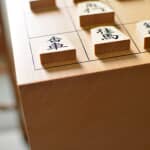Shogi 22 June 2020
Get Better Quickly! Effective Study Methods for Shogi Beginners #7
Hi,
I am Takashi Araki, a Shogi instructor for i-tsu-tsu Shogi classes in Motomachi, Kobe.
This newsletter is called “Furibisha and Ibisha Special” and I will talk about an “opposition form” in which one player uses Furibisha, ranging Hisha (Rook) and the other uses Ibisha, static Hisha (Rook).
Furibish vs. Ibisha!
Writer: Takashi Araki, a former member of Shorei-kai, who has a third dank rank.
1. You Can Customize the Way to Build a Piece Formation.
One of the features of an opposition form is that you can build a piece formation freely. In an Ai-Ibisha situation, in which both players use Ibisha, you must be wary of your opponent making swift attacks and build a castle quickly and simply.
On the other hand, in an opposition form, in an opposition form, it will take a while for the fight to start. You have enough time to build a piece-formation. You can form your defence in place.
As much freedom as you have, it’s tested whether you have a good instinct as a Shogi player. If you have a creative mind, you might want to choose an “opposition from”.
2. Two-Step Process for a Battle
In an Ai-Ibisha situation, the whole things are a fierce battlefield but in an opposition form, that’s hardly ever going to be the case. The reason for this is their position in relation to each other.
In a Furibisha situation, the attackers are placed on the left side of and the defenders are on the right side of the board. On the contrary, in an Ibisha situation, things are reversed.
In short, their attackers don’t direct at their opponent’s castle. This is a big difference from an Ai-Ibisha situation.
When a battle begins, first the attackers from both sides will fight each other. Then when you are done with that, you will launch a secondary attack toward your opponents’ castles.
Even if things don’t work out at first, it still leaves a lot of opportunities for a comeback. This is a great feature of an “opposition form”. If a long battle doesn’t bother you, it’s for you!
3. rone to a Battle in a Limited Space
As I mentioned before, there is a two-step process for an opposition form battle. For example, if a first player is using Furibisha, the first battle will occur in the left side of a board and the second battle will be in the right side.
As you know, battles will occur in one side each time. In Furibisha game, a battle won’t be on the whole board and is prone to be in a limited space.
Especially, at the end of a game, both players will send in more and more forces in one side of the board. The piece formation of that situation will be intricate. The more intricate the situation becomes, the more information to be considered you will have. The situation on a board must become very confusing by a snowball effect.
In an opposition from, during the beginning of a game, you can think things freely and in the middle of the game, it may not be very difficult to deal with the situation. However, when it becomes to the end of a game, the difficulty level jumps all the way up. This is also another feature that Ai-Ibisha doesn’t have.
There is a lot of charm in an opposition form. When you understand both of advantages and disadvantages of Ibisha and Aibisha, you can appreciate Shogi more than now.
クリエイティブ Creative


